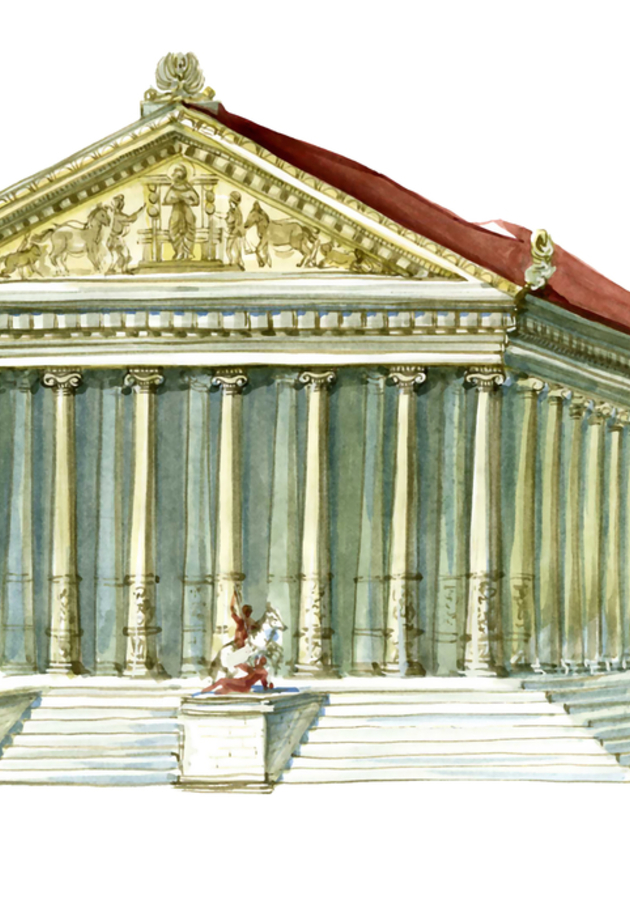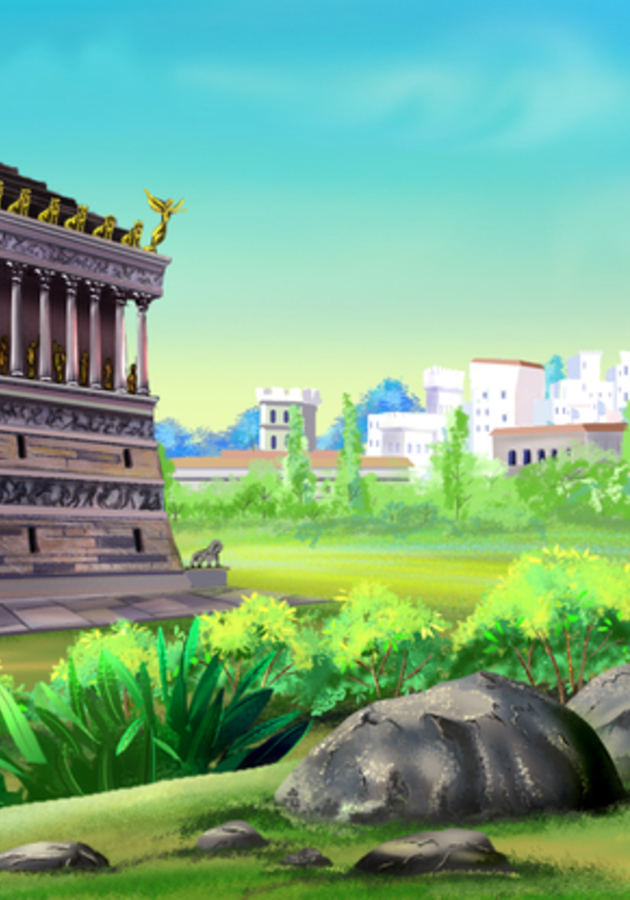When Heinrich Schliemann was seven years old, he discovered, in a picture-book retelling of Homer’s “Iliad,” a vivid image of the burning city of Troy. He couldn’t believe that its walls no longer existed. So, he decided, right then and there, that one day he would be the man to unearth them. He held on to the dream for more than four decades, during which time he acquired immense wealth dealing in raw materials for the production of ammunition. Relieved of financial worries, he retired at the age of 36 with the sole objective of dedicating his fortune and the rest of his life to the pursuit of Troy.
Thirteen years later, to the astonishment of professional archaeologists everywhere, Schliemann discovered the ruins of what he believed to be the Homeric city of Troy, under Hissarlik hill, in the northwest of present-day Turkey. Even though later excavations at the site called his chronology into question, he remains acknowledged to this day as the discoverer of Troy and as a pioneer in the field of archaeology. But the story of the Artemis Temple at Ephesus has nothing to do with Schliemann. It has, incidentally, everything to do with another amateur archaeologist, equally enamored with the classical past but unfairly forgotten, who was excavating ancient ruins in Anatolia at the same time as Schliemann, about 300 miles (500 km) to the south of Hissarlik hill.
Ancient ruins and modern railway stations
Unlike Schliemann, the romantic discoverer of Troy, British railway engineer John Turtle Wood was not a rich man. Hence, even though he shared with his German contemporary both an obsession with the stories of ancient Mediterranean civilizations and a single-minded drive to unearth their cities and monuments, he couldn’t make excavations on the scale of which Schliemann made without some financial help. In trying to obtain a grant from the British Museum, in 1858, about a year after the birth of his son, Wood took a poorly paid appointment to design railway stations for the Smyrna-Aidin Railway Company in Ottoman Turkey. His main objective in applying for the post was to obtain access to an archeological site situated near the small town of Ayasoluk, today’s Selçuk. If Wood’s interpretations of ancient texts were accurate, he expected to find there the ancient city of Ephesus and, in it, the Temple of Artemis, one of the Seven Wonders of the Ancient World.
With little but the remarks of classical authors to go by, Wood couldn’t begin to look for the remains until 1863. In the years which followed, he spent a considerable portion of his personal means to find some indication of the site of the Temple, hoping it would qualify him for a grant from the Trustees of the British Museum. After every sort of vexation and misfortune – including a debilitating illness and at least one suicide attempt – in February 1866, he unearthed a Greek inscription mentioning various gold and silver statuettes which he knew once belonged to the temple. It was the sign he had been looking for, the object that got him the money and the permissions he had chased for so long. Three years later, on New Year’s Eve 1869, an entire decade after he had begun the search, Wood found the white marble floor of the temple, buried beneath 20 feet of sand.
His health as crumbled as the debris of the temple site, he returned to England on April 13, 1874, hailed as a hero and a trailblazer. Indeed, alongside Troy, the Temple of Artemis was one of the first items of lost antiquity to be deliberately sought out by archaeological means. Though the effort cost Wood both his wellbeing and sanity, he was adamant, until the very end of his life, that it was worth it since it brought him immense joy to have his dedication and patience vindicated. Even so, he took no pains to secure his renown. Wood’s modesty, however, was not due to a weakness of character. To quote one of his biographers, “There was never a more determined man setting out on a difficult exploration than this young architect who, with small means and scarcely any data, went to Smyrna to look for a lost wonder of the world, and, in spite of every discouragement, found it.”
At the mercy of Goths and Christians
Sadly, what Wood found at Ayasoluk was no more than majestic wreckage. A full millennium before he stepped foot to the site, the ancient city of Ephesus was abandoned by its people after an earthquake in AD 614 made it insecure for living. Over the years that followed, the Kaystros River slowly flooded the city and almost everything that was left of it and its famous temple went under the silts and the water. Sackings by the Arabs, first in the year 654 by caliph Mu'awiya I, and later in 700 and 716, hastened the decline of Ephesus even further. When the Seljuk Turks conquered the region in 1090, what they found at the site of what was once a busy harbor and a vital comm ercial center at the Anatolian coast was nothing more than a small village. As the passing-through Crusaders discovered soon after, even the Temple of Artemis had disappeared from the memory of the local population.
But, then again, by then, the Temple had disappeared from the memory of history books as well. The last we hear of it is several centuries earlier, at the beginning of the fifth, in a poem by Prudentius which casually mentions the defeat of the huntress-goddess Artemis at the hands of Jesus Christ. About the same time, another Christian poet by the name of Paulinus of Nola says pretty much the same thing, possibly persevering, for posterity, the name of the culprit: “Artemis,” he writes, “has fled from Ephesus, for John has thrust her out.” Now, this John was the Archbishop of Constantinople at the time, and if we are to believe some of his near contemporaries, in AD 401, he led a violent Christian mob to Ephesus. The mob, in no time, razed the Temple of Artemis to the ground. For his evidently valiant efforts, John Chrysostom was posthumously honored with sainthood, not to mention a few fancy epithets such as “the destroyer of demons” or “the overthrower of the temple of Artemis.”
Truth be told, it’s unlikely that John’s mob found anything other than an already ruined temple in Ephesus. In AD 262, a century and a half before the Christians began burning its marble in lime kilns to make cement, the temple was either destroyed or severely damaged in a raid by the Goths, an East Germanic tribe that established a vast kingdom north of the Black Sea in the 3rd century. This is how Edward Gibbon, the preeminent historian of the decline and fall of the Roman Empire, described the event in the 18th century: “The arts of Greece, and the wealth of Asia, had conspired to erect that sacred and magnificent structure, the Temple of Artemis, admired as one of the wonders of the world. Successive empires, the Persian, the Macedonian, and the Roman, had revered its sanctity, and enriched its splendor. But the rude savages of the Baltic were destitute of a taste for the elegant arts, and they despised the ideal terrors of a foreign superstition.”
A tale of two temples
The Goths, Gibbon’s “rude savages of the Baltic,” were neither the first nor the last in a long line of notorious trespassers who failed to treat the goddess Artemis and her temple with adequate honor and respect. Long before them – and only a few years after she had been granted lifetime refuge at the sanctuary by Julius Caesar – Cleopatra’s sister Arsinoë was brutally murdered on its steps at the orders of Roman general Mark Antony. Naturally, he did it so as to be able to acquire the throne of Egypt for himself and Cleopatra, a direct descendant of one of Alexander’s generals, Ptolemy I. Alexander himself had two asylum-seekers forcefully taken out of the temple for execution after he defeated the Persians. Far more appealingly, it is said that the philosopher Heraclitus, a native of the city of Ephesus, awarded himself asylum in the Temple of Artemis with the intention of getting away from the human race, an act as understandable then as it must be today.
Albeit standing at the same site, the Temple of Artemis Heraclitus took refuge in was not exactly the one the ancients admired as a wonder or the one Alexander and Mark Antony desecrated. In antiquity, Ephesus was the site of two successive monumental temples to Artemis. The first one was constructed on the site of earlier shrines around 550 BC, with many of its columns erected at the expense of Croesus, the fabulously wealthy king of the neighboring kingdom of Lydia. It’s unlikely that Croesus ever cast an eye upon his investment because he died soon after, in 546 BC, after rashly losing his legendary Anatolyan kingdom to the Persians. Moreover, if we are to believe ancient authors, this first temple – sometimes conveniently called “the Croesus temple” – wasn’t completed until the period of the Graeco-Persian War, meaning it was slowly raised over the span of an entire century. When finished, it was not just the largest of all Greek temples, but also the first one to be built almost entirely in marble.
Unfortunately, it didn’t last long. On July 21, 356 BC, the night when Alexander the Great was said to have been born, a madman by the name of Herostratus set fire to the wooden staircase of the temple, hoping to immortalize his name. He was, unfortunately, successful: Artemis, say the ancients, was too busy assisting the birth of Alexander to keep an eye on her temple. Even though the Ephesians decreed that the name of the pyromaniac be never recorded, the geographer Strabo revealed it in his Geographica, thereby granting him the immortality he had so desired. Ironically, we don’t know the name of the architect who rebuilt the temple. But we do know that his second temple was even more beautiful than the first one, its model. We also know that it was still not completed when Alexander the Great conquered Ephesus in 334 BC, for he is said to have offered to pay for the finishing-off if he could have his name upon it somewhere. The Ephesians declined the courteous offer, diplomatically saying that "it was inappropriate for a god to dedicate offerings to another god.”
The Temple of Artemis, finally
Almost all histories of the great monuments of antiquity end, inescapably and regrettably, with scenes of destruction and oblivion. Allow us to end this one, purposefully told in reverse, far more cheerily, by revisiting ancient Ephesus during the days when the second Temple of Artemis, that majestic wonder of the ancient world, was first erected. Its story begins almost immediately after Herostratus set the old “Croesus temple” on fire. The very next day, says Strabo, the citizens of Ephesus collected their ornaments and belongings and arranged for the selling of the remains of the burned-down sanctuary. With the money thus collected, they financed the building of a new temple to Artemis, even bigger and better than the previous one. They say that, unlike its predecessor, this second temple was put up with relative ease, within a little over three decades. Significantly larger than the Parthenon, the temple must have looked quite splendid against the blue skies of the eastern Mediterranean when polymath Pliny first visited the site in the early days of the Roman Empire. He didn’t hold back on the superlatives.
Calling the Temple “the most wonderful monument of Grecian magnificence, and one that merits genuine admiration,” Pliny marveled at its size and construction, and was left in awe when he discovered the ingenious means by which its architect solved the issue of setting the heavy architraves in place above the entrance doors. The catch was that only after carving the lintel blocks, he gathered they were too heavy to be lifted (let alone set in place) by a hoist or a crane. Legend says that this realization drove the main architect to such a state of anxiety and desperation as to contemplate suicide. Fortunately, that very night, he was visited in his weary dream by the goddess Artemis, who urged him to live on, and finish her temple. The following morning, the architect awoke with a splendid idea. To the astonishment of everybody present, he began piling up sandbags upon an inclined plane until they reached beyond the capitals of the columns. Then, as he gradually emptied the lower bags, the architraves insensibly settled in the places assigned for them.
Measuring 180 x 360 feet (55 x 100 m), the temple occupied an area larger than that of a football field. Around it ran an elaborate frieze, and there were lion-headed waterspouts adorning the courtyard. Three windows pierced the roof pediment, the central one providing a “window of appearance” through which worshippers at the altar could see their goddess. As for the columns themselves, they were Ionic and 127 in number, each of them 60 feet (20 m) high. The visual appearance of such a forest of columns was a new thing in Greek temple building at the time, as were the carved reliefs on 36 of them. All in all, the Temple of Artemis was a sight to behold. Indeed, Antipater of Sidon, the man who made the earliest list of wonders to survive to this day, declared it the most magnificent of all seven. Philo of Byzantium went one better. “Whoever has gazed upon the Temple of Artemis,” he wrote, “has also observed, for at least one brief moment, our earthly world changing places with the heavenly sphere of the immortals.”
Sources
Main
- Paul Jordan, Seven Wonders of the Ancient World (Routledge, 2002).
- Christopher Scarre, ed. The Seventy Wonders of the Ancient World (Thames & Hudson, 1999).
- James Grout, “Temple of Artemis at Ephesus,” Encyclopaedia Romana. [https://penelope.uchicago.edu/~grout/encyclopaedia_romana/greece/paganism/artemis.html]
- Jane Burr Carter, “Temple of Artemis (Artemision), Ephesos,” An Encyclopedia of the History of Classical Archaeology [Nancy Thomson de Grummond, ed.] (Greenwood Press, 1996), pp. 1077-78.
Ancient
- Anthologia Graeca ix.58.
- Aulus Gellius, Attic Nights ii.6.18. [https://topostext.org/work.php?work_id=208]
- Herodotus, Histories i.92. [http://www.perseus.tufts.edu/hopper/text?doc=Perseus%3Atext%3A1999.01.0126%3Abook%3D1%3Achapter%3D92]
- Philo of Byzantium, “On the Seven Wonders of the World,” RogerPearse.com [Translation by Jean Blackwood] (August 23, 2019). [https://www.roger-pearse.com/weblog/2019/08/23/philo-of-byzantium-on-the-seven-wonders-of-the-world-an-english-translation-and-some-notes/]
- Pliny, Natural History xxxvi.21. [http://www.perseus.tufts.edu/hopper/text?doc=Perseus%3Atext%3A1999.02.0137%3Abook%3D36%3Achapter%3D21]
- Strabo, Geographica xiv.1.22 [http://www.perseus.tufts.edu/hopper/text?doc=Perseus%3Atext%3A1999.01.0198%3Abook%3D14%3Achapter%3D1%3Asection%3D22]
Other
- Peter D’Epiro & Mary Desmond Pinkowish, What Are the Seven Wonders of the World?: And 100 Other Great Cultural Lists (Anchor, 1998), pp. 179-187.
- Jennifer Rosenberg, "Temple of Artemis at Ephesus," ThoughtCo (August 6, 2021). [https://www.thoughtco.com/temple-of-artemis-at-ephesus-1435670]
- St John Ervine, "John Turtle Wood, Discoverer of the Artemision 1869,” Isis, Vol. 28, No. 2 (May, 1938), pp. 376-384. [https://www.jstor.org/stable/225696]
- Edward Gibbon, Decline and Fall of the Roman Empire i.10.3. [https://www.ccel.org/g/gibbon/decline/volume1/chap10.htm]
- Torsten Landsberg & Sabine Oelze, “Recalling Heinrich Schliemann, excavator of Troy,” DW (April 8, 2020). [https://www.dw.com/en/recalling-heinrich-schliemann-excavator-of-troy/a-53063144]





























